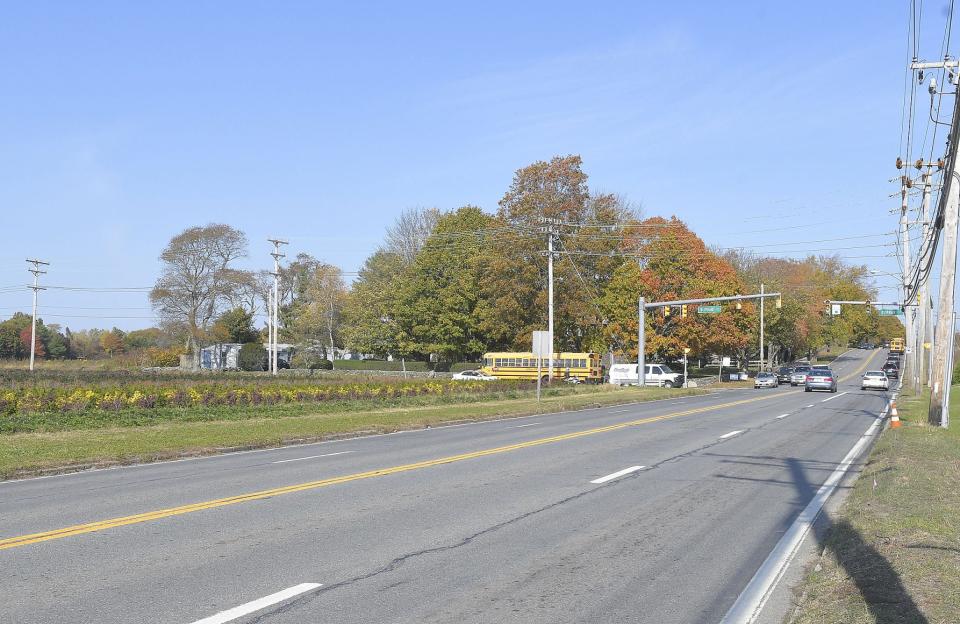Could East Main Road in Middletown go on a diet? Why a deadline to decide is approaching
MIDDLETOWN – Town Council last week voted to have a hearing on April 15 on whether to turn a stretch of East Main Road into a three-lane route to slow down traffic as part of a proposed repaving project on that section of the road.
The move comes after the Rhode Island Department of Transportation argued against the move and Town Administrator Shawn Brown said RIDOT might not conduct the scheduled paving project unless the town decides by April 19.
Council members hope to render a decision before April 19 and plan to get more traffic data for the April 15 hearing.
At the last two Town Council meetings, members of Bike Newport and other road diet proponents complained that paving that approximate 2-mile stretch between Mitchell’s Lane and Wyatt Drive would be an opportunity to improve safety, especially for pedestrians and bicycle riders.

“My concern with delaying the project is if we do delay, there is no certain date when the project would move forward and it is likely it would bump into other projects like repaving of West Main Road and interrupting projects on Aquidneck Island,” Brown told the council at its last meeting.
He said with the Washington Bridge issue in Providence, as well as litigation over tolls, there is no telling when the repaving would move forward.
“Funding for transportation projects in the state is highly competitive. There is not a lot of money out there,” Brown added.
Brown referenced the concerns for those who ride bicycles but said there is no bike plan yet in place.
In a letter to Brown, RIDOT engineer Robert Rocchio said that putting that stretch of East Main Road on a “diet” by trimming a driving lane would cause traffic congestion during the summer months, especially during peak travel hours, and cause traffic to spill over to Mitchell Lane and Wyatt Drive. He also mentioned how it would be more difficult for motorists turning onto East Main Road from unsignalized side streets, as well as driveways on East Main Road.
In his letter, Rocchio referenced a letter and a traffic study conducted by VHB, a design and engineering company that collaborates with RIDOT. That letter from last July highlighted the pros and cons of trimming that stretch of East Main Road. The pros include fewer lanes to cross. The cons include the issues cited by Rocchio.
VHB also said that it recommends these “diets” for locations where the traffic is under 20,000 vehicles per day for the state’s road diet program. According to VHB’s data, that stretch of town logs 21,500 vehicles per day during the summer months and 17,500 during the spring.
VHB mentioned that RIDOT does not recommend it and that the traffic puts the area on the high end of the road dieting threshold.
Though RIDOT does not recommend a road trim, it has left the final decision to the Town Council.
Bari Freeman, executive director of Bike Newport, said that VHB’s data is outdated and from 2018.
Referencing her group’s meetings with state and other officials, she said that data from 2023 would reveal that the new traffic volume would be more within RIDOT’s recommended range for a road diet.
Freeman also said that VHB did not list bicycle and pedestrian safety as one of its pros because its safety improvement is an automatic pro.
“It is already accepted as the number one approach,” she said.
Freeman also mentioned other positives. She said a slowdown would be good for local businesses along that stretch, causing more cars to stop and shop there.
Councilwoman Emily Tessier, a frequent bike rider, said both constituents and her own work clients have told her that they feel their safety and lives are in danger when riding or walking on that stretch of road.
Tessier said national data shows that road diets improve safety and there needs to be more infrastructure to support pedestrians and bike riders.
“I don't see how we can argue facts. This clearly works in other places throughout the country. I can't see how we can’t try it here, even for one week, and see if it works,” she said.
Tessier referenced a proposal to phase in the diet plan. Under that plan, the state would begin its first round of paving and then lines would be drawn to generate a three-way thoroughfare before finalizing the last phase of paving.
Brown said such a plan is not part of the initial project and would change the scope at the last minute.
Council Vice President Thomas Welch III also argued heavily in favor of the diet plan.
“I am willing to give this a whirl to slow everybody down,” he said. “This is our chance. If we don't do this, it will never come again.”
Council President Paul M. Rodrigues argued against it and said that Portsmouth, which shares East Main Road, is not in favor of such a slow down.
He and others said it would be hard to move forward without the support of Middletown’s neighbor.
Others also argued against it, including Bill Robertson, who lives on one of the unsignalized side streets.
Robertson said that traffic there already makes it difficult to turn on to East Main Road. He said walking across it is also a difficult task.
“I take exception to it being called a road diet. It’s going to become a road bloat and basically it will create two miles of non-stop traffic jams,” Robertson said.
This article originally appeared on The Providence Journal: Middletown council plans hearing as East Main Road diet deadline nears

